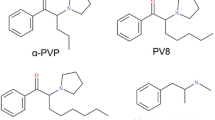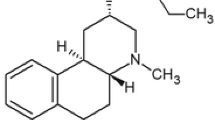Summary
The influence of imipramine treatment on apomorphine-induced behavior was studied. Imipramine was administered twice a day for 14 days at 10 mg/kg. The control group received a single dose of imipramine. Both groups were tested at 48 hours after imipramine administration, using open field; the number of line crossings and episodes of rearing and looking into holes were counted as part of the exploratory behavior. Repeated, but not single, administration of imipramine increased the exploratory activity induced by apomorphine injection an effect which was blocked by haloperidol pretreatment. The results indicate that repeated imipramine administration enhances the sensitivity of brain dopamine receptors related to exploratory behavior.
Similar content being viewed by others
References
Angst J, Dobler-Mikola A (1984) The definition of depression. J Psychiat Res 18: 401–406
Archer J (1973) Tests for emotionality in rats and mice: a review. Anim Behav 21: 205–235
Bernardi M, Palermo-Neto J (1984) Effects of the apomorphine administration on rearing activity of control and experimental rats withdrawn from long-term haloperidol treatment. Gen Pharmacol 15: 363–365
Costall B, Naylor R (1973) On the mode of action of apomorphine. EurJ Pharmacol 21: 350–361
Daniel W, Adamus A, Melzacka M, Szymura M, Vetulani J (1981) Cerebral pharmacokinetics of imipramine in rats after single and multiple dosage. Nauyn Schmiedebergs Arch Pharmacol 317: 209–213
Delini-Stula A, Vassount A (1979) Modulation of dopamine-induced behavioral responses by antidepressants: effect of single and repeated treatment. EurJ Pharmacol 58: 443–451
Fink J, Smith G (1980) Mesolimbicocortical dopamine terminal fields are necessary for normal locomotor and investigatory exploration in rats. Brain Res 199: 359–384
Fray P, Sahakian B, Robbins T, Koob G, Iversen S (1980) An observational method for quantifying the behavioral effects of dopamine agonists: contrasting effects of d-amphetamine and apomorphine. Psychopharmacology 69: 253–259
Isaacson R (1982) The limbic system. Plenum Press, New York
Javoy-Agid F, Agid T (1980) Is the mesocortical dopaminergic system involved in Parkinson's disease? Neurology 30: 1326–1330
Maj J (1984) Central effects following repeated treatment with antidepressant drugs. Pol J Pharmacol Pharm 36: 87–99
Maj J, Rogóz, Skuza G, Sowińska H (1984) Repeated treatment with antidepressant drugs increases the behavioral response to apomorphine. J Neural Transm 60: 273–282
Maj J, Wedzony K (1985) Repeated treatment with imipramine or amitryptyline increases the locomotor response of rats to (+)-amphetamine given into the nucleus accumbens. J Pharm Pharmacol 37: 362–364
Mayeux R, Stern Y, Rosen J, Leventhal J (1981) Depression, intellectual impairment, and Parkinsons disease. Neurology 31: 645–650
Melzacka M, Wiszniowska G, Vetulani J (1978) The distribution of apomorphine in rat brain: possible behavioral correlates. Pol J Pharmacol Pharm 30: 335–345
Randrup A, Braestrup C (1977) Uptake inhibition of biogenic amines by newer antidepressant drugs: relevance to the dopamine hypothesis of depression. Psychopharmacology 53: 309–314
Rurak A, Melzacka M (1985) Effects of some antidepressant drugs on apomorphine concentration in the central nervous system of rats and apomorphine-induced stereotypy. Pol J Pharmacol Pharm 37: 509–515
Scatton B, Simon H, Le Moal M, Bischoff S (1980) Origin of dopaminergic innervation of the rat hippocampal formation. Neurosci Lett 18: 125–131
Simon H, Le Moal M, Calas A (1979) Efferents and afferents of the ventral tegmental area-A 10 region studied after local injection of [3H] leucine and horseradish peroxidase. Brain Res 178: 17–40
Smiałowski A (1985) Stimulation of hippocampal dopaminergic receptors: behavioral and electrophysiological effects. Pol J Pharmacology Pharm 37: 333–345
Smiałowski A, Bijak M (1986) Repeated imipramine treatment increases the responsivity of the rat hippocampus to dopamine. Anin vitro study. J Neural Transm 66: 189–196
Smiałowski A, Maj (1985) Repeated treatment with imipramine potentiates the locomotor effect of apomorphine administered into the hippocampus in rats. Psychopharmacology 85: 295–298
Van Praag HM (1984) Precursors of serotonin, dopamine and norepinephrine in the treatment of depression. In: Lemberger L, Reidenberg M (eds) Proceedings of the second world conference on clinical pharmacology and therapeutics. Bethesda, pp 541–555
Vetulani J (1984) Complex action of antidepressant treatment on central adrenergic system: possible relevance to clinical effects. Pharmacopsychiatry 17: 16–21
Walsh R, Cummins R (1976) The open-field test: a critical review. Physiol Bull 83: 482–504
Willner P (1983) Dopamine and depression. A review of recent evidence. Brain Res Rev 6: 211–246
Author information
Authors and Affiliations
Rights and permissions
About this article
Cite this article
Smiałowski, A. Repeated imipramine enhances sensitivity of the brain dopaminergic system related to exploratory behavior. J. Neural Transmission 69, 201–209 (1987). https://doi.org/10.1007/BF01244341
Received:
Revised:
Issue Date:
DOI: https://doi.org/10.1007/BF01244341




